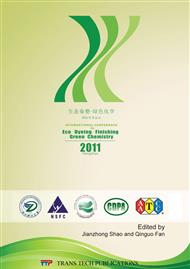p.1
p.5
p.10
p.16
p.23
p.28
p.33
p.44
Sustainable Cotton Dyeing
Abstract:
Conventional methods of dyeing cotton with direct and fiber reactive dyes involve large amounts of water and salt and generate significant amounts of highly colored effluent that is difficult to treat in waste water treatment facilities. Cationization of cotton with 3-chloro-2-hydroxypropyltrimethylammonium chloride allows dyeing with direct and fiber reactive dyes with less water and energy usage as well as the eliminating the need for salt. This paper summarizes work to date on the benefits of using cationized cotton.
Info:
Periodical:
Pages:
1-4
Citation:
Online since:
January 2012
Authors:
Price:
Сopyright:
© 2012 Trans Tech Publications Ltd. All Rights Reserved
Share:
Citation:


